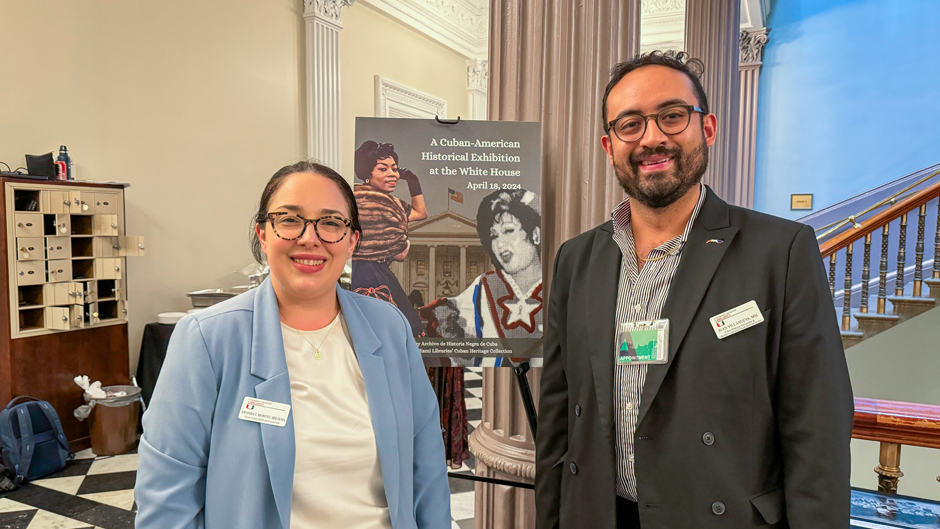The White House opened its doors last Thursday to many Cuban Americans, including administrators of the Cuban Heritage Collection (CHC), one of University of Miami Libraries most storied collections and the largest repository of archival material on Cuba and the Cuban diaspora.
The CHC was selected to show an exhibition of its archives at “Cuban American Day at the White House,” an opportunity to recognize the Cuban American community’s contributions and their history with a briefing for invited guests, followed by a reception.
“The White House invitation to the Cuban Heritage Collection to formally participate in the Cuban American Day celebration reflects widespread recognition of the CHC’s preeminent role in ensuring the preservation and dissemination of knowledge about the history of Cuba and its diaspora,” said Charles “Chuck” Eckman, dean of the libraries. “I couldn’t be more thrilled.”
About 100 members of the Cuban American community were invited to the gathering, which took place in the Eisenhower Building, a wing of the White House. Felice Gorordo, The World Bank’s alternate executive director for the United States, welcomed the group, and was followed by a keynote speech from Alejandro Mayorkas, secretary of the Department of Homeland Security who shared his family’s migration story from Cuba in the 1960s.
He was introduced by fellow Cuban American Carlos Del Toro, the secretary of the Navy. Also in attendance was the assistant secretary for employment and training at the U.S. Department of Labor, José Javier Rodriguez, a former state senator from Miami-Dade County.
Legendary Afro-Cuban jazz pianist Chucho Valdés performed during the event, as well.
The Cuban Heritage Collection co-curated the exhibition with Marley Pulido Vargas, creator of “Historia Negra de Cuba,” a digital archive that promotes and preserves the Black historical memory of the island and its diaspora.
Amanda Moreno, director and Esperanza Bravo de Varona Chair of the collection, travelled to the event along with Juan Villanueva, Cuban heritage and Spanish language collections archivist.
“The Cuban Heritage Collection was honored to participate in Cuban Day at the White House, where we were able to highlight the importance of preserving our community's cultural heritage in the diaspora,” said Moreno.
“Collaborating with ‘Historia Negra de Cuba’ on the pop-up exhibition was an incredible opportunity for us to showcase our diaspora holdings, from photographs and publications documenting José Martí's time in New York and Florida in the 1800s to newsletters and magazines focusing on the various waves of Cuban migration to the U.S. after the 1959 revolution,” she added.
The exhibit was displayed in tables lining the hallways of the meeting room. The exhibition was made up of 26 reproductions of materials from the Cuban Heritage Collection archives and 13 items from “Historia Negra de Cuba’s” collection. Items from the Cuban Heritage Collection included:
- The first and last pages of the guidelines that founded the Cuban Revolutionary Party, José Martí’s political party, established while he was in exile in the U.S. Pictures of Martí, a Cuban national hero and patriot, at the San Carlos Institute in Key West and in Ybor City in Tampa, Florida.
- Anti-communist pamphlets produced by the Directorio Revolucionario Estudiantil, a student activist group that opposed Fidel Castro.
- Publications and photographs from the Cuban Refugee Center documenting the arrival of Cubans to Miami in the early 1960s.
- Photographs of Little Havana businesses in the 1960s and 1970s from the Lydia Cabrera papers and the Arva Moore Parks Photograph Collection.
- A promotional brochure from the 1970s television program “¿Qué Pasa, USA?”
- Periodicals documenting the experience of migrants after the Mariel boatlift of 1980 when they were sent to Fort Chaffee in Arkansas, demonstrating the perspectives of the refugees (“La Vida Nueva”) and the soldiers at Fort Chaffee that were tasked with guarding and caring for them (The Crossroads).
- Periodicals and ephemera from the rafter crisis of the 1990s, including a maritime rescue log from the Brothers to the Rescue records that lists the names of people picked up at sea; a hand-drawn newspaper titled “Éxodo” produced by refugees at Guantánamo Bay Naval Base refugee camp; and a leaflet warning of land mines around the Guantánamo Bay Naval Base.
During a reception, Moreno and Villanueva were able to speak with many members of the audience. Some of the attendees were familiar with the Cuban Heritage Collection, but others were not. They were happy to look at the documents and learn more about the archives, Moreno said.
“I hope the audience was able to see the diversity of the Cuban diaspora community's lived experience, and that our materials represent varied social identities across race, gender, sexual identity, and socioeconomic status,” said Moreno.

